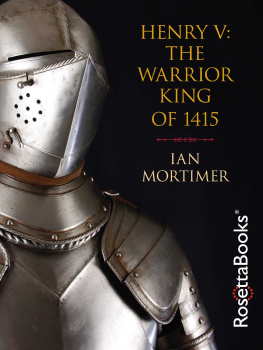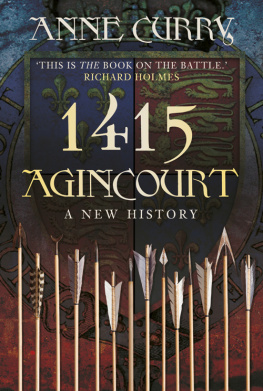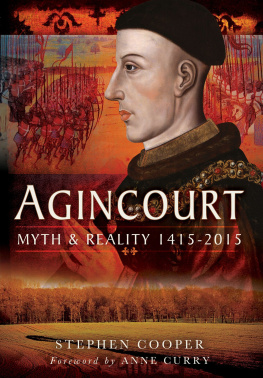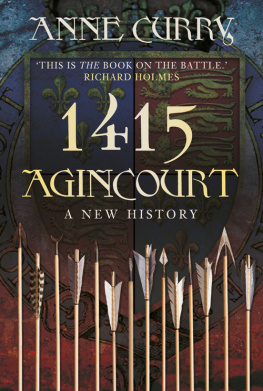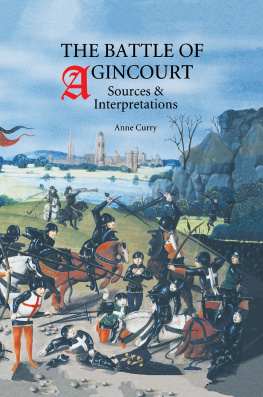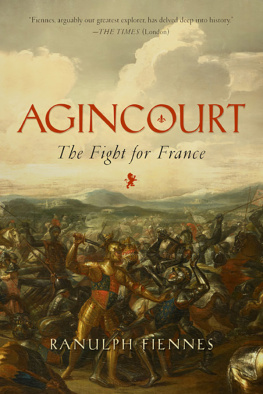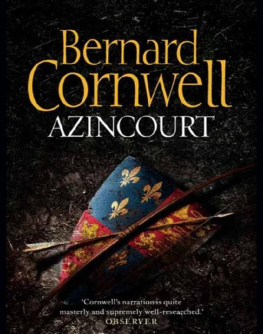THE MARCH
And taking many a fort,
Furnished in warlike sort,
Marcheth towrds Agincourt
In happy hour;
Skirmishing day by day
With those that stoppd his way.
Where the French general lay
With all his power.
MICHAEL DRAYTON: Agincourt
The taint of the usurpers son still lingered painfully in Henrys mind as he surveyed the councillors now awaiting his decision. The words of the Archbishop of Bourges You have no right! still stung. He had embarked on this enterprise in the hope of a tangible glory evidenced in captured lands and towns. By now, the beginning of October, he should have achieved something to justify, in England, not only the heavy financial outlay but also his own position, so that his sovereignty could never again be disputed.
With dismay he reviewed the outcome of these grueling weeks in France. One small harbour town was his where by now he should be in control of provinces. Even as his masons and carpenters began the rebuilding of Harfleur he knew with appalling certainty that the prospect of further conquest was slim. Of the 9,000 men he had brought from England, at least 2,000 were dead, the majority from sickness, including at least 1,500 of the priceless archers. One of the dead was Henrys friend Sir John Philip. His tomb in St Marys, Kidderminster, records their friendship, says he fought well at Harfleur, and died on 2 October. Moreover, men who had survived the dysentery were debilitated and downcast. Two ships, the Catherine and the Holy Ghost from Winchelsea, had lately anchored laden with provisions for the rebuilding which included rope, glue, coal and grain. Now they took aboard more sick troops destined for home. A thousand further men could be discounted; whatever course was next decided upon, these must stay to garrison Harfleur.
Henry had planned originally to march from Harfleur along the Seine valley, enter Rouen and Paris and then go south-west in triumph to Bordeaux, a distance of some 350 miles. Now, as the surgeons brought their dreadful daily bulletins, he recognised the impossibility of his scheme. With him were now little over half the fighting force which had set out two months earlier. Winter was approaching, the weather sharpening. Rations were once more alarmingly low. The trees were shedding their leaves; for miles around the fields were bare. Anyone but Henry would have been tempted to return home, borrow more money, gather fresh forces and set out again next summer to complete the campaign. But by then the first burning inspiration would have been lost for ever, the curse of the usurpers son would be whispered, and Gods cause would be mocked. To abandon the enterprise now was unthinkable. Even with the decimated, demoralised force, the watchwords were still prowess and glory glory or death.
He had with him a mere 900 men-at-arms and 5,000 archers. Yet his mind was set. At the War Council he announced that the army should go forward to Calais; a chevauche on which they would do battle with any army seeking to block their path and during which they would take what gains they might. The chevauche, literally meaning a ride, had become a popular feature of military strategy and involved much pillaging en route, meanwhile provoking the enemy into offering battle or at least weakening his resistance and resources should no battle be offered. Once at Calais, the army could be re-victualled and perhaps gather reinforcements from the Earl of Warwicks garrison there.
The councillors were appalled at his temerity. It had been established that Charles dAlbret had a growing force at Rouen, near which such a chevauche would need to pass. South-east was the Dauphin, at Vernon, and he was capable of moving as soon as the army left its entrenched position at Harfleur. The dying Earl of Arundel pointed out the additional threat of Jean sans Peur of Burgundy, who could summon a magnificent force to King Charless aid if he so wished, and whose equivocal attitude could resolve itself at any moment.
And yet, sitting in the Council pavilion near the poisonous marsh, hearing the grave-diggers spades, Henry was adamant, prepared for risk and hazard. He was willing to march with his frail army and dwindling supplies through unknown territory. On the opposite bank of the estuary at Honfleur, the camp fires of Marshal Boucicauts army could be seen; this in itself was a spur, yet not half so keen as the reckless resolution burning in Henry. It was an insanity of glory, underlined by the constant belief that the cause was Gods. Now they must march fast, slip past dAlbrets force at Rouen and be across the Somme, the greatest obstacle but the river nearest to Calais, before the Dauphins troops at Vernon could join dAlbrets in a pincer movement and cut them off. He told his Council:
I am possessed with a burning desire to see my territories and the places which ought to be my inheritance. Even if our enemies enlist the greatest armies, my trust is in God, and they shall not hurt my army nor myself. I will not allow them, puffed up with pride, to rejoice in misdeeds, nor unjustly, against God, to possess my goods. They would say that through fear I have fled away acknowledging the injustice of my cause. But I have a mind, my brave men, to encounter all dangers, rather than let them brand your King with word of ill-will. With the favour of God we will go unhurt and inviolate, and if they attempt to stop us, victorious and triumphant in all glory.
He issued final orders. Apart from Dorset, who was to stay as governor of Harfleur, Sir Thomas Erpingham, Sir Gilbert Umfraville, Edward, Duke of York, Sir John Cornwall and Sir John Holland and all the other commanders were to make ready. The chevauche would move off at dawn.
The army was relieved to be quitting the noxious graveyard of Harfleur, but the sun had departed and white mist lapped the horses hooves to the pasterns as the columns rolled forward in the October morning. As speed was paramount, the army travelled light, with provisions for only eight days. Henry planned to march at the rate of seventeen miles per day, a rate determined by the foot-soldiers and wagons. Even he was unsure of the distance (160 miles) to Calais, judging it less than it really was. The route too was uncertain, and the only available maps must have been crude and obscure. There was need to rely on the childhood memories of old knights such as Thomas Erpingham, who recalled the route taken by Edward III on his way to triumph at Crcy. There were two rivers to be crossed before the Somme the Bthune and the Bresle and several small towns to pass during these crossings, among them Fcamp, Arques, and Boves.
The best place to ford the Somme appeared to be a tidal cattleford five miles downstream from Abbeville named the White Spot (Blanche-Tque), over which Edward IIIs army had moved in a formation of twelve abreast. It must have crossed the minds of the commanders that Edwards army had been vastly different from the one now setting out: a well-provisioned, well-fed army, healthy and strong, whereas the men now loading the pack-animals with their gear looked pitiful. They were grim-faced from hunger and siege, their jacques and gloves and shoes of boiled leather already rotting from the damp, their wounds only half-healed, their helmets battered. The lords plate armour was stowed on the backs of the sumpter-horses and as many weapons as could be carried at speed were piled into carts. The three great guns which had broken into Harfleur were of necessity left behind at the garrison. The chevauche was a desperate gamble.
Hours before the march began, Henry sent a team of fast couriers ahead to Calais telling the Earl of Warwick to expect him and, more important, to send a decoy contingent of troops to engage any force of dAlbrets that might come south of the Somme to block the armys path. Everything depended on an unhindered fording of Blanche-Tque, and all was speculation: whether Burgundy would suddenly move either to help King Charles or, contrarily, the English invader; whether the French would submit to watching this small impudent force march unmolested through upper Normandy; whether that force could outmarch any opposition spearheaded from Rouen.




